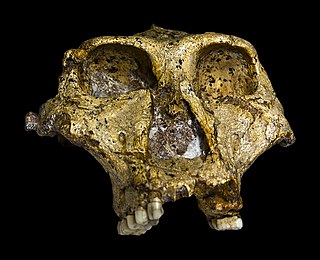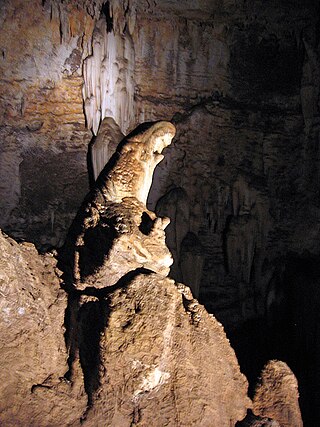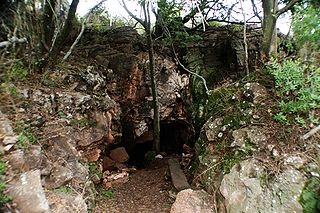
The Ditsong National Museum of Natural History, formerly the Transvaal Museum, is a natural history museum situated in Pretoria, South Africa. It is located on Paul Kruger Street, between Visagie and Minnaar Streets, opposite the Pretoria City Hall. The museum was established in 1895 by the former South African Republic, also known as the Transvaal. In 2010 it was one of the founding museums of Ditsong Museums of South Africa.

The Cradle of Humankind is a paleoanthropological site and is located about 50 km (31 mi) northwest of Johannesburg, South Africa, in the Gauteng province. Declared a World Heritage Site by UNESCO in 1999, the site is home to the largest concentration of human ancestral remains anywhere in the world. The site currently occupies 47,000 hectares (180 sq mi) and contains a complex system of limestone caves. The registered name of the site in the list of World Heritage Sites is Fossil Hominid Sites of South Africa.

Sterkfontein is a set of limestone caves of special interest in paleoanthropology located in Gauteng province, about 40 kilometres (25 mi) northwest of Johannesburg, South Africa in the Muldersdrift area close to the town of Krugersdorp. The archaeological sites of Swartkrans and Kromdraai are in the same area. Sterkfontein is a South African National Heritage Site and was also declared a World Heritage Site in 2000. The area in which it is situated is known as the Cradle of Humankind. The Sterkfontein Caves are also home to numerous wild African species including Belonogaster petiolata, a wasp species of which there is a large nesting presence.

Mrs. Ples is the popular nickname for the most complete skull of an Australopithecus africanus ever found in South Africa. Many Australopithecus fossils have been found near Sterkfontein, about 40 kilometres (25 mi) northwest of Johannesburg, in a region of Gauteng now designated as the Cradle of Humankind World Heritage Site. Mrs. Ples was discovered by Robert Broom and John T. Robinson on April 18, 1947. Because of Broom's use of dynamite and pickaxe while excavating, Mrs. Ples's skull was blown into pieces and some fragments are missing. Nonetheless, Mrs./Mr. Ples is one of the most "perfect" pre-human skulls ever found. The skull is currently held at the Ditsong National Museum of Natural History in Pretoria.

Krugersdorp is a mining city in the West Rand, Gauteng Province, South Africa founded in 1887 by Marthinus Pretorius and Abner Cohen. Following the discovery of gold on the Witwatersrand, a need arose for a major town in the west of the reef. The government bought part of the Paardekraal farm and named the new town after the Transvaal president, Paul Kruger. Krugersdorp no longer has a separate municipal government after it was integrated into Mogale City Local Municipality along with surrounding towns. It is now the seat of government for Mogale City.
Taung is a small town situated in the North West Province of South Africa. The name means place of the lion and was named after Tau, the King of the Barolong. Tau is the Tswana word for lion.

Swartkrans is a fossil-bearing cave designated as a South African National Heritage Site, located about 32 km (20 mi) from Johannesburg. It is located in the Cradle of Humankind World Heritage Site and is notable for being extremely rich in archaeological material, particularly hominin remains. Fossils discovered in the limestone of Swartkrans include Homo ergaster, Paranthropus and Homo habilis. The oldest deposits present at the site are believed to be between 1.9 and 2.1 million years old.

The Evolutionary Studies Institute (ESI) is a paleontological, paleoanthropological and archeological research institute operated through the Faculty of Science of the University of the Witwatersrand, Johannesburg, South Africa. Previously known as the Bernard Price Institute for Palaeontological Research (BPI) it was renamed the Evolutionary Studies Institute in 2013 to better showcase the scope of its research.

The Bothongo WonderCave in Kromdraai, Gauteng, South Africa is situated within the Bothongo Rhino & Lion Nature Reserve in the Cradle of Humankind, a UNESCO World Heritage Site. The cave is the third-largest cave chamber in the country. It is 5-10 million years old. The single chamber has an area of 46,000 square metres (500,000 sq ft), and is 125 by 154 metres.
Cooper's Cave is a series of fossil-bearing breccia filled cavities. The cave is located almost exactly between the well known South African hominid-bearing sites of Sterkfontein and Kromdraai and about 40 kilometres (25 mi) northwest of Johannesburg, South Africa and has been declared a South African National Heritage Site.
Gladysvale Cave is a fossil-bearing breccia filled cave located about 13 kilometres (8.1 mi) northeast of the well-known South African hominid-bearing sites of Sterkfontein and Swartkrans and about 45 kilometres (28 mi) north-northwest of Johannesburg, South Africa. It is situated within the Cradle of Humankind World Heritage Site and is itself a South African National Heritage Site.
Motsetsi Cave is a fossil-bearing breccia filled cavity located about 14 kilometres (8.7 mi) east of the well known South African hominid-bearing sites of Sterkfontein and Kromdraai and about 45 kilometres (28 mi) north-northwest of Johannesburg, South Africa. Motsetsi has been declared a South African National Heritage Site.

Plovers Lake Cave is a fossil-bearing breccia filled cavity in South Africa. The cave is located about 4 km Southeast of the well known South African hominid-bearing sites of Sterkfontein and Kromdraai and about 36 km Northwest of the City of Johannesburg, South Africa. Plovers Lake has been declared a South African National Heritage Site.
Kromdraai is a fossil-bearing breccia-filled cave located about 2 kilometres (1.2 mi) east of the well-known South African hominid-bearing site of Sterkfontein and about 45 kilometres (28 mi) northwest of Johannesburg, South Africa. It is situated within the Cradle of Humankind World Heritage Site and is itself a South African National Heritage Site.

Section 27 of the National Heritage Resources Act (NHRA) of South Africa provides for places of historic or cultural importance to be designated national heritage sites. This came into effect with the introduction of the Act on 1 April 2000, when all former national monuments declared by the former National Monuments Council and its predecessors became provincial heritage sites as provided for in Section 58 of the Act.

Malapa is a fossil-bearing cave located about 15 kilometres (9.3 mi) northeast of the well known South African hominid-bearing sites of Sterkfontein and Swartkrans and about 45 kilometres (28 mi) north-northwest of Johannesburg, South Africa. It is situated within the Cradle of Humankind World Heritage Site.

Muldersdrift, in the Gauteng Province of South Africa, is a picturesque rural area situated 27 km north-west of the CBD of Johannesburg, between Johannesburg and the Magaliesberg mountain range. The area falls under the West Rand District Municipality, and is part of Mogale City.
Bolt's Farm is a palaeontological site in the Cradle of Humankind World Heritage Site, Gauteng province, South Africa. With more than 30 fossil deposits dating back 4.5 Ma, it is one of the oldest sites currently discovered in the Cradle of Humankind. It consists of multiple cavities, pits, and quarries, where caves have eroded away, exposing their fossiliferous interiors. Although this site has not yet yielded the hominid fossils for which the Cradle of Humankind is known, Bolt's Farm is still an important source of fossils from various species of Early Pliocene and Plio-Pleistocene fauna, including primates and big cats.
Minnaar's Cave, or simply Minnaar, is a palaeontological site located in the Cradle of Humankind World Heritage Site, Gauteng province, South Africa. Lost after its discovery in the 1930s, its location was rediscovered in 2009. It is known for its well-preserved jackal skulls, dating to the Plio-Pleistocene at least 2 million years ago.













